President Nelson announced eight new temples in General Conference on Sunday. This keeps up his pace from last year, when he announced 16 new temples across the two Conferences. Actual construction of all these new temples hasn’t kept up, though. Ground was broken for 11 new temples in 2019, but none have been started this year. This is why President Nelson’s spree seems to me to be more one of temple announcing than temple building. In any case, thinking about this gap between announced temples and built temples motivated me to look back at the data on the Church’s pace of the announcing, beginning construction on, and dedicating temples across the past few decades.
The graph below shows the year-by-year count of how many temples were announced, had construction begin, and were dedicated each year since 1950. I took the data from the list of temples on the Church website, and from Wikipedia where the information wasn’t available on the Church website because a temple is not yet dedicated or is being renovated.
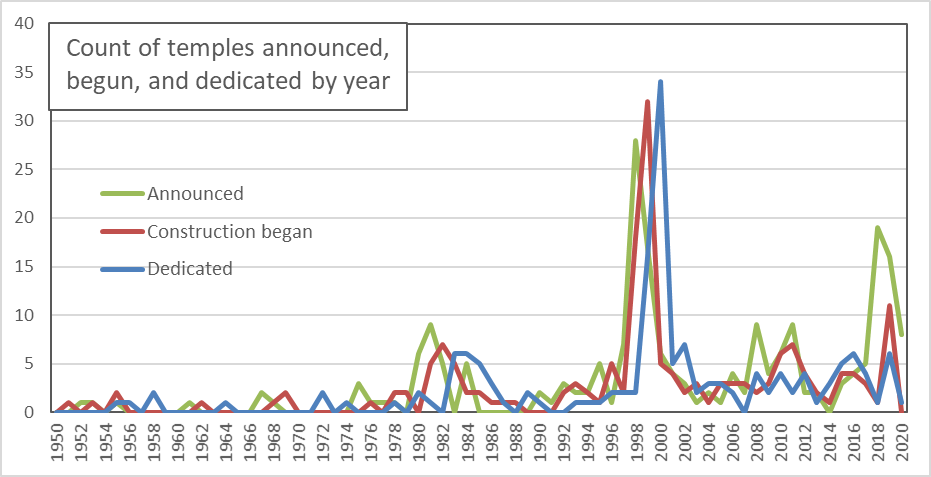
The most obvious feature of the graph is the giant spike around the turn of the millennium, when President Hinckley started the Church building smaller temples, and then pushed to get 100 temples completed by the end of the year 2000. You can see how the spike appears first in announcements, then in construction starts, and finally in dedications. There’s also an earlier spike in the 1980s that it looks like didn’t get resolved nearly as fast as the Hinckley-era spike. Finally, looking to more recent years, there are some peaks in temple announcements during President Monson’s tenure, but later in his time in office, they really declined, before suddenly jumping to 19 in 2018, and then as I already mentioned, to 16 last year and eight so far this year. Looking at President Nelson’s approach to announcing temples, and the fact that President Monson clearly was quite sick in his past few years, I wonder if President Nelson wasn’t the architect of the dramatic increase even before he became Church President.
Another way to look at this same data is to check, for a particular point in time, the status of all temples that have been announced. How many haven’t had construction begin? How many are under construction? And how many are complete? I checked the status of all 225 temples that the Church has announced or built as of the end of quarter (i.e., March 31st, June 30th, etc.) for each year since 1950. At the end, I included June 30th, 2020, even though it hasn’t happened yet, so I could include the eight new temples that were just announced.
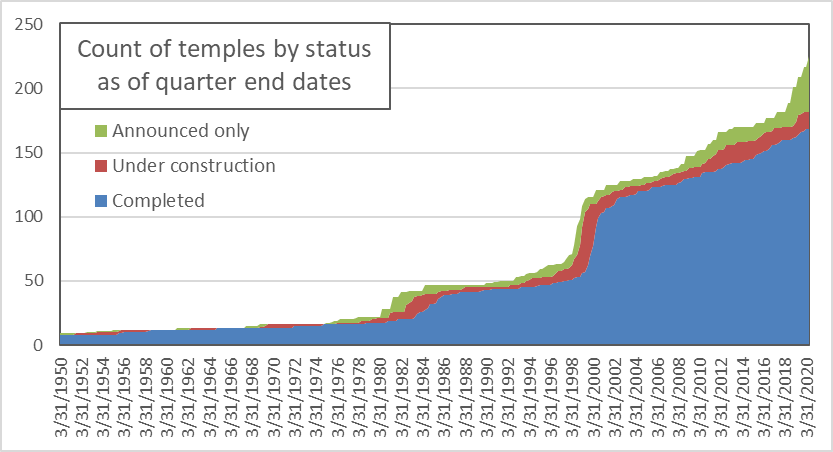
I like how this graph shows the gradual addition of completed temples for the first few decades, and then the spike in the early 1980s that was slowly worked through from announced to under construction to completed (note that the announced and under construction pieces almost disappear in the late 1980s). The Hinckley-era spike is in there too, in the bend in the late 1990s, and then at the end, the Nelson-era spree of announcements shows up at the top.
The completed temples so dominate the graph above, though, that I thought it might be interesting to split out and look at just the temples that are either announced only or under construction.
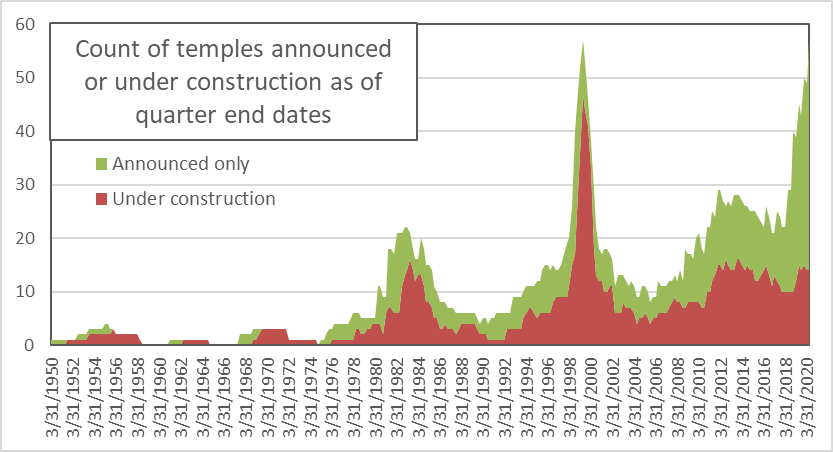
With the completed temples removed, you can really see how big the Nelson increase is. The current count of 57 temples either announced or under construction ties the peak number during the Hinckley era, which was for June 30th, 1999. But, as you can see in the graph, the Hinckley-era peak was mostly temples under construction (47) versus announced only (10). The current situation is almost the reverse, with 14 under construction and 43 only announced. And this isn’t an effect of the coronavirus either. As of December 31st of last year, there were 15 temples under construction and 35 only announced.
A possible objection to this graph is that by ignoring completed temples, it exaggerates the Nelson spike in announcements, which might not be that big as a percentage of all temples. In this next graph, I am still only showing the announced only and under construction temples, but rather than showing them as counts, I am showing them as percentages of all temples that had been announced to date (i.e., including all completed temples).
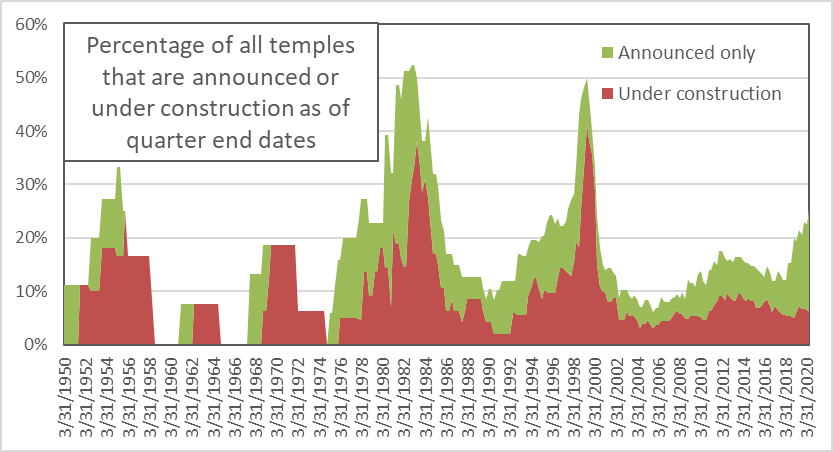
This really reduces down the Nelson-era spike, and it also makes the Kimball-era spike in the early 1980s look a lot bigger. The Church announced 20 new temples between 1980 and 1982. That wouldn’t be all that many now, but as of the end of 1979, the Church only had 17 temples, so the plan was to more than double the number. Similarly, the Hinckley-era spike included 45 temples announced in two years (1998 and 1999) when the Church had 51 temples as of the end of 1997. President Nelson’s total is 43 announced in two and a half years (giving him credit for 2018), but that’s from a starting count of 160 at the end of 2017, so it’s nothing like the previous announcements that roughly doubled the number of temples, and it doesn’t show up as being nearly as big in this graph.
Going back to the first graph, though, what seems clear is that unless the Church really ramps up temple construction, there is going to be a big backlog of temples that have been announced but not built, or in many cases, even started. In the Hinckley-era spike, construction followed announcement, as the 45 new temples announced in 1998-1999 were followed by 50 temples being dedicated in those same years. The Church’s current construction isn’t keeping pace in at all the same way. There have been 43 temples announced since the beginning of 2018, and only 12 completed.
I’ve seen some people say that this is kind of a vanity project for President Nelson, where he wants to stamp his name on a bunch of temples that he likely won’t live to see completed. This might be a little harsh, but it doesn’t seem unreasonable to me. Certainly putting his stamp on other aspects of the Church seems very important to him, what with releasing an official proclamation and a new logo and renaming Church-associated things like the Mormon Tabernacle Choir at Temple Square.
Regardless of the reason, though, in announcing temples that likely won’t be completed for many years, the Church is borrowing against future member enthusiasm in some sense. Especially if President Nelson keeps this up for a few more years, future Church presidents will face the harsh reality of either announcing fewer (or no!) new temples, likely for a span of years, or just exacerbating the problem and announcing temples that won’t actually be built for for decades.
This last graph shows, for temples completed during each year since 1980, the average number of months elapsed since the temple had been announced. For context, I also show the number of temples completed each year by the blue area. I put markers on the average months data series to try to make it easier to see around the gap years when no temples were completed.
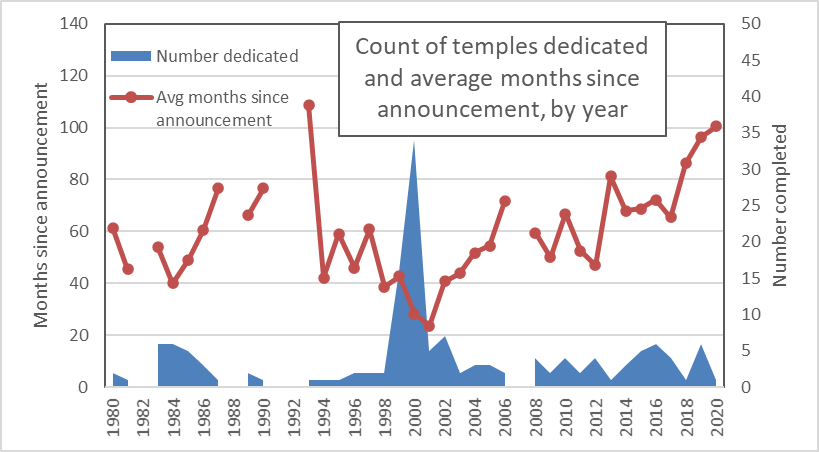
Temples completed in the past few years have gone an average of over seven years from announcement to completion. This figure is likely to only increase, probably dramatically, unless the Church drastically increases its temple-building efforts.
Ziff I love all of your statistical posts, thanks for having the interest in and taking the time to create them. As I’ve heard of so many temples being announced I’ve had some of the same thoughts that you’ve expressed here. I’ve also wondered how needed some of these temples really are. I know from personal experience that Utah temples are generally quite crowded and new ones are needed but that probably isn’t the case for many of the other new ones. I especially wonder about the temple in Yuba City California that was announced a while back. Yuba City has a population of 65,000 and is less than an hours drive from Sacramento where there is an existing temple. I’m still puzzled over the need for a Yuba City temple.
I have a suggestion for another statistical project that I thought of doing but I know you could do it much better and quicker than I can. Once again this past general conference I was annoyed by the constant quoting and praising of our current prophet. In the Saturday morning session it seemed like every speaker mentioned him, quoted him and praised him multiple times. This seems to be something new, I don’t recall such hero worship in years past. But maybe I’m wrong, maybe I just never noticed it before. I thought it would be interesting to go back to previous conferences and see how many times the current prophet’s name is mentioned and how many times he is quoted by speakers to see if this is something new.
I would put proposed temples into three categories:
1. Urgently needed temples. Apparently, the ones announced for the Wasatch Front fall into that category. It would be interesting to see if there is any correlation between church membership density and speed of construction.
2. Projected-need temples. I suspect that most Latin American, Asian, and African temples fall into that category. the question then becomes, what is the members-served threshold a prospective temple needs to cross before it should be announced? Perhaps President Nelson has lowered that bar. I don’t know. But as long as the temples are eventually built, I am fine with announcing them. I grew up in a church that told us nothing (financial disclosure, anybody?). Announcing temples early at least gives us a clue about what financial obligations we are planning to take on. But if the projections are wrong and the temples are never build, some future prophet will undoubtedly wish we had never announced them.
3. Political statement temples. The Russia temple certainly fall into this category. It is strictly aspirational and was (IMHO) announced largely to send a signal to the Russian saints that we are not letting Vladamir Putin drive us out. I believe that the Russia temple will eventually be built, but it could skew your statistics significantly in the mean time. The Dubai temple probably falls into the same category. We don’t really need a temple there and won’t any time soon. But if they invited us to build it, we would be foolish not to. It’s a tangible foothold in the Middle East and could be a gamechanger if we handle it well. The Bangalore and Phnom Penh temples might also fall into this category–I’m not really sure.
KLC, thanks! I’m glad you like this type of post. I think you make a good point about need for temples in sparsely-populated places. Also, the question about who gets quoted in Conference is an interesting one, and I’m actually looking at it now, but as part of a larger project that’s taking a while, so unfortunately I’m not sure how long it will be before I post about it.
Last Lemming, great breakdown! I particularly think the political statement temples are interesting. Have any that have been built in the past fallen into this category? I think the Freiberg, Germany one maybe does, given that it was built behind the Iron Curtain. I don’t recall how that was rolled out, though, whether there was an early announcement followed by time to work out details, or if it was kept under wraps until it was a sure thing.
Ziff, sounds interesting, I’ll be looking for it when you have it ready. Last Lemming, your category 2 is what I’ve always called “Field of Dreams” temples, build them and they will come. Theoretically, building the temple will create demand. But we already have experience with that model. Sixty years ago Henry D. Moyle applied it to chapel building and it nearly bankrupted us.
Ziff,
Freiberg, Germany, definitely falls into the political statement category, but all the contracts were already signed before church membership got a whiff of it. Elder Monson had several high level meetings with GDR leadership, including party chairman Erich Honecker, before most people in the COB even had an inkling.
Thanks, Elizabeth, for supplying the background!
Russell Nelson announces temples, but in a departure from previous patterns, he dedicates almost none. Members of the Quorum of the Twelve dedicated five temples in 2019. Only seven previous temples since Nauvoo had been dedicated by someone not of the church’s First Presidency. Details at the link:
https://www.jrganymede.com/2019/12/20/temple-dedication-delegation/
I wonder how much the poor quality of recent temples impacts the building of new temples. Rebuilding (Raleigh, NC) or renovating (DC and SLC) probably draw from the same Church talent pool as building new temples. Those people can only do so much at one time. The Philly temple took 8 yrs from announcement to dedication and there was no opposition. Perhaps the temple department has too much inventory in the pipeline to efficiently manage with current resources.
I work in a DC government office bldg older than the DC temple and which gets far more use than the DC temple, but it does not have be shut down regularly for renovations. What gives with the DC temple and other temples that require major renovations fairly early in their lifespan, at least compared to commercial buildings that get far more at regular use and wear and tear? All of the renovations probably add up to another brand new temple or two every couple of years.
Yes, the temple department is really, really busy.
Thanks, John. That’s an interesting pattern! I wonder what motivates different Church Presidents to decide to do or not do most of the temple dedications themselves.
rb, that’s a good point. I’m sure they’re swamped, as you point out, between renovations and new construction.